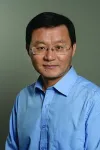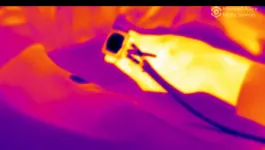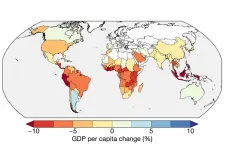(Press-News.org) COLUMBIA, Mo. – For more than 10 years, Guoliang Huang, the Huber and Helen Croft Chair in Engineering at the University of Missouri, has been investigating the unconventional properties of “metamaterials” — an artificial material that exhibits properties not commonly found in nature as defined by Newton’s laws of motion — in his long-term pursuit of designing an ideal metamaterial.
Huang’s goal is to help control the “elastic” energy waves traveling through larger structures — such as an aircraft — without light and small “metastructures.”
“For many years I’ve been working on the challenge of how to use mathematical mechanics to solve engineering problems,” Huang said. “Conventional methods have many limitations, including size and weight. So, I’ve been exploring how we can find an alternative solution using a lightweight material that’s small but can still control the low-frequency vibration coming from a larger structure, like an aircraft.”
Now, Huang’s one step closer to his goal. In a new study published in the Proceedings of the National Academy of Sciences (PNAS), Huang and colleagues have developed a prototype metamaterial that uses electrical signals to control both the direction and intensity of energy waves passing through a solid material.
Potential applications of his innovative design include military and commercial uses, such as controlling radar waves by directing them to scan a specific area for objects or managing vibration created by air turbulence from an aircraft in flight.
“This metamaterial has odd mass density,” Huang said. “So, the force and acceleration are not going in the same direction, thereby providing us with an unconventional way to customize the design of an object’s structural dynamics, or properties to challenge Newton’s second law.”
This is the first physical realization of odd mass density, Huang said.
“For instance, this metamaterial could be beneficial to monitor the health of civil structures such as bridges and pipelines as active transducers by helping identify any potential damage that might be hard to see with the human eye.”
“Active metamaterials for realizing odd mass density,” was published in the Proceedings of the National Academy of Sciences (PNAS). Other MU contributors include Qian Wu, Xianchen Xu, Honghua Qian, Shaoyun Wang, Zheng Yan and Hongbin Ma. Grants from the Air Force Office of Scientific Research and the Army Research Office funded the research.
Editor’s Note: For more on the story, please see:
Creating an artificial material that can sense, adapt to its environment
Designing a flexible material to protect buildings, military personnel
Aviation Enhancements, Better Biosensors Could Result from New Sensor Technology
Scientists ‘bend’ acoustic and elastic waves with new metamaterials that could have commercial applications END
Smart material prototype challenges Newton’s laws of motion
University of Missouri researchers designed a prototype of a small, lightweight active ‘metamaterial’ that can control the direction and intensity of energy waves.
2023-05-18
ELSE PRESS RELEASES FROM THIS DATE:
MSU researchers uncover the hidden complexity of the Montmorency tart cherry genome
2023-05-18
Highlights:
Michigan State University researchers sequenced the Montmorency tart cherry genome for the first time.
This will have a major impact on all future tart cherry research and breeding efforts worldwide.
Michigan is the nation’s leading producer of tart cherries.
EAST LANSING, Mich. – Since Michigan is the nation's leading producer of tart cherries, Michigan State University researchers were searching for the genes associated with tart cherry trees that bloom later in the season to meet the needs of a changing climate. They started by comparing DNA sequences from late-blooming ...
Historical fiction: a guarantee of critical success or a trap?
2023-05-18
For 21st century authors, the odds of writing a critical hit are much higher if the novel takes place in the past, not the present or future. Between 2000 and 2020, about three quarters of the novels shortlisted for the National Book Award, the Pulitzer Prize, and the National Book Critics Circle Award took place in the historical past.
“As a reader, you may not have even noticed the growing infatuation with history in literature because the historical novel has become such a diversely practiced form by such a wide array of writers, it's almost become invisible to us as a genre in itself,” ...
Using 3D printing to improve implantable biomedical devices, touchscreens and more
2023-05-18
McGill researchers are exploring a new technique that uses 3D printing and hydrogels. It has the potential not only to improve biomedical implants but could also be useful in the development of human-machine interfaces such as touch screens and neural implants. Biomedical devices like pacemakers or blood pressure sensors that are implanted into the human body need to be fabricated in such a way that they conform and adhere to the body – and then dissolve at the right time.
Using 3D printing and hydrogel technology, researchers in McGill University’s Department of Engineering ...
Amputees feel warmth in their missing hand
2023-05-18
“When I touch the stump with my hand, I feel tingling in my missing hand, my phantom hand. But feeling the temperature variation is a different thing, something important... something beautiful,” says Francesca Rossi.
Rossi is an amputee from Bologna, Italy. She recently participated in a study to test the effects of temperature feedback directly to the skin on her residual arm. She is one of 17 patients to have felt her phantom, missing hand, change in temperature thanks to new EPFL technology. More importantly, she reports feeling reconnected to her missing hand.
“Temperature feedback is a nice ...
In years after El Niño, global economy loses trillions
2023-05-18
In the years it strikes, the band of warm ocean water spanning from South America to Asia known as El Niño triggers far-reaching changes in weather that result in devastating floods, crop-killing droughts, plummeting fish populations, and an uptick in tropical diseases.
With El Niño projected to return this year, Dartmouth researchers report in the journal Science that the financial toll of the recurring climate pattern can persist for several years after the event itself—and cost trillions in lost income worldwide. The study is among the first to evaluate the long-term costs of El Niño and projects losses that far exceed ...
Fear of large predators drives smaller predators into areas they perceive as safer, but where risk is greater
2023-05-18
Medium-sized carnivorous species – mesopredators like coyotes or bobcats – tend to move into human-dominated areas to avoid predation by larger carnivores, a phenomenon also known as the “human shield” effect. However, according to a new study, doing so places these safety-seeking species at considerably greater risk for mortality due to human activities. The findings describe a “paradox of the lethal human shield” for mesopredators, which could become an increasingly important driver of carnivore community dynamics and ecological trophic structures as species restoration and recovery efforts expand the coexistence of ...
Ancient history of kissing and its role in disease transmission
2023-05-18
In a Perspective, Troels Arbøll and Sophie Rasmussen review the ancient history of kissing, particularly the emergence of romantic-sexual kissing in Mesopotamia more than 4000 years ago and its role in the evolution and spread of orally transmitted diseases like herpes simplex virus 1 (HSV-1). They say the kiss cannot be regarded as a sudden biological trigger causing a spread of specific pathogens, as some research has recently proposed. “Evidence indicates that kissing was a common practice in ancient times, potentially representing a constant influence on the spread of orally transmitted microbes, such as HSV-1,” ...
Global analysis reveals widespread decline in lake water storage worldwide
2023-05-18
The amount of water stored in more than half of the largest lakes and reservoirs worldwide is declining, according to a new study. This drying is largely attributable to a warming climate and increased human impacts. The findings underscore the importance of accounting for these impacts in future surface water resources management strategies. Although they cover roughly 3% of the global land area, lakes hold 87% of Earth’s liquid surface fresh water. These features also provide essential ecosystem services and are key components in global biogeochemical processes. Many of these benefits are modulated by lake water storage (LWS), which ...
Unmanaged global forests have limited carbon sequestration potential
2023-05-18
Even if all direct human management of global forests ended immediately, their carbon sequestration potential would not be enough to curb ongoing climate change, according to a new study. The findings suggest that the planet’s current forests have only limited remaining carbon storage potential – even under the most unlikely of scenarios – to substantially mitigate atmospheric carbon dioxide (CO2) without major reductions in emissions. By capturing and storing carbon in biomass and soil organic matter, forests are integral to the global carbon cycle. As a result, the planet’s forests are often considered a central component in climate ...
Half of world's largest lakes losing water
2023-05-18
More than 50 percent of the largest lakes in the world are losing water, according to a groundbreaking new assessment published today in Science . The key culprits are not surprising: warming climate and unsustainable human consumption.
But lead author Fangfang Yao, a CIRES visiting fellow, now a climate fellow at University of Virginia, said the news is not entirely bleak. With this new method of tracking lake water storage trends and the reasons behind them, scientists can give water managers and communities insight into how to better protect critical sources of water and important regional ecosystems.
“This is the first comprehensive assessment of trends ...
LAST 30 PRESS RELEASES:
Deep ocean earthquakes drive Southern Ocean’s massive phytoplankton blooms, study finds
Without campus leftovers to pick through, the beaks of this bird changed shape during the pandemic
High-dose antibiotic does not reduce mortality in tuberculous meningitis
How many insects fly in the sky above the USA?
Could cheese protect your brain health?
Who faces more difficulty recovering from stroke?
Colliding galaxies create the brightest, fastest growing black holes at their center
New BrainHealth research reveals tradeoffs on sleep with cannabis use for chronic pain
Aging-US now on ResearchGate, enhancing visibility for authors and readers
'Molecular glue' stabilizes protein that inhibits development of non-small cell lung cancer
Mount Sinai Health System is recognized in 2025 Chime Digital Health Most Wired survey
From prey to predator: How carnivores spread beneficial fungi
Menopause symptoms may be frequent and have negative effects, according to female endurance athletes
US Congressmembers’ responses on X to mass shooting events differ along party lines
KAIST-UEL team develops “origami” airless wheel to explore lunar caves
Individual genetic differences render some therapies ineffective
Engineering dendritic cells boosts cancer immunotherapy
Sophisticated neuroimaging reveals PTSD in WTC responders is linked to measurable physical changes in brain structure
Health policy experts identify promising strategies for providing health care to homeless people
Study explores role of neutrophils in canine atopic dermatitis
Mayo Clinic researchers develop AI-ECG model to diagnose liver disease earlier
Heavy menstruation common among teenage girls – questionnaire reveals risk of iron deficiency
New study explores why open water swimming feels so powerful for midlife women
In echo of Jurassic Park, mosquitoes capture entire ecosystems in their blood meals
Marty Cooper, Illinois Tech Alumnus and ‘Father of the Cell Phone,’ Receives 2025 Marconi Society Lifetime Achievement Award
How to reduce the risk of lymphedema
NEJM Evidence and CIDRAP announce Public Health Alerts
New fossil study illuminates on the evolutionary success of frogs
Patient-specific human liver model to understand disease mechanisms
Confused by the doctor's questionnaire? U of A study suggests it's common
[Press-News.org] Smart material prototype challenges Newton’s laws of motionUniversity of Missouri researchers designed a prototype of a small, lightweight active ‘metamaterial’ that can control the direction and intensity of energy waves.




